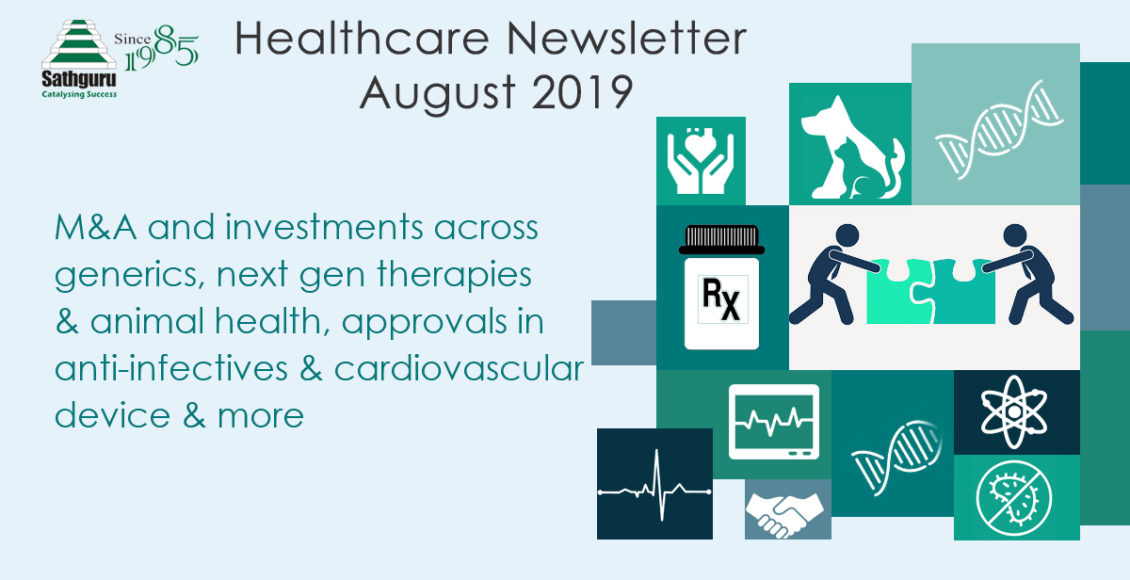

The month of August brought much neededrespite to the long dry spell in the anti-infectives segment. Lower returns on investments and corporate/investor appetite have been major impediments for innovation advancement. The World Health Organization (WHO) recognizes antimicrobial resistance as one of the biggest public health threats, responsible for over 700,000 deaths annually around the world. There is an imminent need for research into novel drug molecules with new mechanisms or site of action along with a controlled use of antibiotics to address drug resistance at the grassroots.
August witnessed two approvals from FDA for novel drugs targeting multi-drug resistant (MDR) infections: Lefamulin and Pretomanid. Nabriva’s Lefamulin (Xenelta), a first-in-class antibiotic, was approved for treatment of Community Acquired Bacterial Pneumonia (CABP) caused by the most common gram-positive and gram-negative bacteria associated with the disease, including Streptococcus pneumoniae, methicillin-susceptible Staphylococcus aureus, Mycoplasma pneumonia, and Haemophilus influenzae. The drug belongs to the class of pleuromutilins, a novel antibiotic class with a mechanism of action that offers a low propensity for the development of drug resistance.
Another notable approval was granted to Pretomanid, developed by the non-profit TB Alliance, for use in combination regimen with bedaquiline and linezolid. The drug regimen targets extensively drug resistant, treatment-intolerant or nonresponsive multidrug resistant pulmonary Tuberculosis. This approval also marks the second time a drug is being approved under the Limited Population Pathway for Antibacterial and Antifungal Drugs, a pathway to spur development of drugs targeting infections that lack effective therapies.
In addition to approval of novel anti-infectives, the month saw support for other multi-stakeholder approaches as well to address AMR. It is encouraging to note Pfizer Foundation’s announcement of Global Health Innovation Grants to NGOs, non-profits and social enterprises in 12 low- and middle-income countries working on health challenges associated with infectious diseases and Antimicrobial Resistance (AMR). Recipients ofeach grant receive US $100,000, with a total investment of US $2 million by the Pfizer Foundation. The recipients include an entity in Nepal that will setup e-learning modules on AMR across health facilities in the country. While these efforts are important developments towards tackling the AMR problem, all stakeholders need to recognize that the momentum needs to be enhanced multifold given the magnitude of the global challenge. In hope we stay, for tackling the most underrated public health problem of our times.

Next-generation solutions across cell and gene therapies continue to be the most promising area of biopharma investment. Industry investment momentum continued unabated in August with Bayer’s acquisition of remaining 59% stake in BlueRock Therapeutics, a joint venture with Versant Ventures forged in 2016. Bayer will pay Versant $240 million in cash at closing and an additional $360 million upon achievement of certain predefined milestones. BlueRock Therapeutics’ portfolio of induced-pluripotent stem cells (iPSC) platform-based cell therapies is currently focused on neurology, cardiology and immunology with a lead program in Parkinson’s disease expected to enter the clinic by the end of 2019. Another notable investment is Pfizer’s USD $500 million expansion of its gene therapy manufacturing plant. The facility currently manufactures for late-stage experimental treatments for Duchenne Muscular Dystrophy (DMD) and hemophilia B, and other gene therapies using recombinant adeno-associated virus vectors.
In addition to expanding corporate investment in manufacturing and late stage assets, August was also significant for the evolving regulatory landscape across the world. Specifically, an encouraging development was in South Korea where the Ministry of Ministry of Health and Welfare is seeking to revise the Bioethics Act. The current law permits gene therapy research only if some extracting conditions are met, such as when there is no currently available therapy for specific diseases such as cancer and AIDs. Most importantly, the Ministry is proposing removing the constraint of specific diseases which implies that gene therapy solutions can then be pursued for any condition where there is no available therapy. In addition to this, the bill also calls for greater ethical responsibility of researchers, entails review and approval by an institutional review board and direct investigation by the National Bioethics Committee. Adoption of this two-pronged approach: granting more liberty to conduct research and at the same time, keeping it under scrutiny from a bioethics perspective seems to be a strategy favored by several countries that are seeking to revise the regulatory framework in the light of recent advances leveraging gene editing and other gene correction tools.

Given the continued pricing pressure and a difficult market landscape, several generic companiesare reconsidering breadth of growth plans charted. Substantial pruning and narrowing of growth strategies is anticipated to continue over the next year or two in this segment. This month, Lupin divested the Japanese injectables business under its subsidiary Kyowa Pharmaceutical Industry Co Ltd. to UAE based pharmaceutical company Neopharma. This adds another transaction to the stream of recent mergers and divestitures fueled by a common thread of underlying motivations: increasing focus on core competencies, increased emphasis on certain specialty indications or strategically narrowing portfolio focus. The month has been strongly steeped with speculations around Perrigo contemplating merger of its generics business with Amneal, a deal which could bring up to $1.5 billion in cash to Perrigo in the current economically tense times. Earlier this year Novartis had strategically spun out its eye care products business Alcon to focus on higher-margin yielding therapeutic areas. This spin-off followed a 2018 sale of Sandoz’s US dermatology and generic oral solid portfolios to Aurobindo Pharma.
Another mega-transaction underway is Mylan’s merger with Pfizer’soff-patent medicines unit Upjohn. The merged entity with an estimated revenue of $19 to $20 billion will surpass those of its closest rival Teva and provide a breather for Mylan’s stressed financials. The combined entity is a strategy to weather the storm by combining Pfizer’s distribution strengths in China and emerging markets with Mylan’s regulated markets focused portfolio. Overall, we anticipate strategic transactions to continue in the generics segment where pricing pressures may not easily immediately. The same stress is also anticipated to drive diversifications investments from traditional generic companies, and specialty pharma could stand to gain. However, in the interest of affordability and access, we hope stability dawns soon and generics re-emerges attractive for industry.

August was a significant month for the cardiovascular devices market, with three cardiovascular devices receiving FDA’s breakthrough device designation. Israel based V-Wave’s Heart failure shunt was the first device this month to receive FDA’s breakthrough device designation; this minimally invasive implant functions as an arterial shunt and is designed to alleviate pressure on the left side of the heart and reduce the buildup of fluid in the lungs. The company is now enrolling patients in in its pivotal investigational device exemption (IDE) trial.
The second cardiovascular disease receiving FDA’s breakthrough device designation is Miracor’s PiCSO Impulse System, based on concept of pressure-controlled intermittent coronary sinus occlusion (PICSO). The device, the PiCSO Impulse System, is designed to increase blood flow to the affected part of the heart, thereby reducing the damage during an infarction that occurs in patients experiencing an ST-elevated myocardial infarction, also known as a STEMI. By helping in the reduction of infarct size, Miracor’s device may provide a breakthrough in the management of STEMI that currently has a 14% one-year mortality rate despite use of reperfusion strategies and adjuvant pharmacological therapies.
The use of minimally invasive devices has been expanding as patients seek better mobility and recovery, along with improvedclinical outcomes. This month, FDA expanded indications for use of both the Edwards Lifesciences’ Sapien 3 valve and Medtronic’s CoreValve Evolut Transcatheter Aortic Valve Replacement (TAVR) system to low risk patients who may be younger and more active than higher-risk patients, re-asserting that overall mobility and quicker recovery-time through the use minimally-invasive devices and procedures is the new market driver.
CVRx’s Barostim Neo device is another device that gained FDA’s breakthrough device designation approval for patients at high risk for heart failures. The device is an implantable device that electrically stimulates the baroreceptors of the carotid artery to reduce heart failure symptoms in advanced heart failure patients. The devices does this through monitoring and management of the blood flow to the heart made possible by synchronizing the functions of the carotid artery and the brain.Neuromodulation is most commonly indicated for relief of chronic pain, and various forms of nerve stimulation are also used to treat Parkinson’s disease, epilepsy, psychiatric disorders and other conditions. However, CVRx’s device is the first device to combine the power of brain and nervous system to effectively manage cardiovascular disease. Both Miracor’s PiCSO and CVRx’s Barostim Neo address a huge clinically unmet need in patients with advanced cardiovascular disease who fail to receive benefit from existing standard treatments.

Historically, business of animal health had been dominated by the animal health divisions of big pharma companies with few stand alone specialty players participating in the global top 10. However, in the last few years, the trend of animal health business units being spun out of major pharma companies has gained continued momentum. The latest of many reorganizations is Bayer’s sale of its animal health business to Elanco, an Eli Lilly spin off in a cash and stock transaction worth $7.6 billion. With Bayer’s eventual divestiture, three of the five largest animal health companies—Zoetis, Elanco and the Bayer unit—will be independent companies. Rounding out the top five are Merck Animal Health and Merial (Boehringer Ingelheim), which remain divisions of their big pharma parent.
At the end of this transaction, Elanco is likely to emerge as a strong portfolio driven global major in animal health. As pharma giants hustle to keep their boats sailing in tough business environments, several of the big pharma companies have spun off their non-core business units, like the animal health business to concentrate more on core valuable assets. At the same time, the animal health segment has begun to gain traction of its own and emerge as an attractive growth and investment opportunity. While animal health is still a moderate to high growth segment across regions, it is often dwarfed in size by its pharma brethren. Past few years have witnessed an increase in people’s willingness to spend on companion animals, led by rising disposable incomes and changing lifestyles. Evolving trends have driven the adoption of innovative technologies such as big data, artificial intelligence in animal health and medicine too. Irish biotech company Nuritas and Stonehaven Incubate, an animal health group committed to creating new companies from disruptive human technology, have entered into a joint venture to use cutting-edge AI technology to discover and develop advanced animal health solutions, with an initial focus on exploring feed ingredients. Novel biotech led solutions for veterinary oncology are increasingly being pursued by venture funded startups. Local competition in global regions is heating up within the animal health segment gaining popularity as a growth avenue for pharma companies. While reorganizations spell a pruning intent from big pharma, they might be the precursor of the animal health segment gaining prominence on its own.

Featured Mandates:
1. Opportunity for licensing and strategic partnership for a recombinant GLP – 1 asset
2. Divestiture of midsize IVD diagnostic company (reagents & POC) in India with robust market footprint and strong product pipeline
Connect with us at lifesciences@sathguru.com to learn more.
Featured publication:
Sathguru to partner with STEM (Society for Technology Management) in 2019 STEM Annual Summit- highlighting the latest innovation trends and the best practices of technology management in public and private sector. Know More
 Grow Beyond
Grow Beyond 


